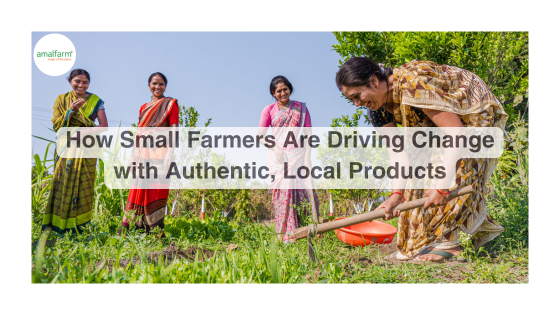
The Future of Agri-Business: How Small Farmers Are Driving Change with Authentic, Local Products
amalfarm2024-10-14T06:17:39+00:00
Small farmers play a vital role in shaping the future of agri-business, especially in low- and middle-income countries where they provide essential food supply and preserve biodiversity. In India, where agriculture employs 43% of the workforce, smallholders owning less than 2 hectares of land account for 86% of all farmers.
However, they struggle with low incomes and limited access to markets, technology, and efficient logistics. To create a sustainable future, it’s crucial to empower these farmers by improving their value capture and fostering growth in the agricultural ecosystem.
By focusing on authentic, local products and leveraging technology, small farmers are not only driving change but also contributing to a more equitable and sustainable agri-business landscape. This transformation promises to reshape the farm-to-fork ecosystem for the better.
The Role of Small Farmers in Agri-Business
Smallholders play a crucial role in food production, especially in India and other developing nations, where they form the backbone of agriculture. In India alone, small farms account for 86% of the total farming community, producing a significant share of the country’s food supply. These small farms sustain the livelihoods of millions and ensure food security for local populations.
Beyond food production, small farms are also guardians of biodiversity. By cultivating traditional crops and using sustainable practices, they preserve local varieties and contribute to land stewardship, helping maintain ecological balance.
Today’s consumers are increasingly interested in local, authentic products with clear origins. Smallholders cater to this demand by offering region-specific, GI-tagged, and organic products, providing transparency and quality. Their ability to produce traceable, high-quality goods is reshaping the market, making small farmers key drivers in the future of agri-business.
Who Will Be These Small Farmers?
Over 410 million farms globally are very small, with less than 1 hectare of land, while another 70 million are between 1 and 2 hectares. However, simply looking at farm size doesn’t tell the full story. A small farm with fertile, irrigated land may produce more than a larger one with poor soil. Factors like soil quality, market access, and infrastructure play a huge role in determining the productivity of small farms.
These small farms are incredibly diverse but can be categorized into three types: commercial, transition, and subsistence-oriented.
Commercial small farmers run their farms as businesses but also rely on Rural Non-Farm Employment (RNFE) for extra income. As urban demand grows, they diversify, growing fruits, vegetables, and livestock. Some focus on traditional export crops like cocoa or coffee, while others shift to more specialized, high-value products.
Transition farmers maintain small plots but depend on RNFE. Some may expand into commercial farming if they have access to growing markets, while others keep one foot in farming and another in RNFE for stability.
Subsistence-oriented farmers are the most vulnerable. Located in remote areas with poor infrastructure, many face barriers like discrimination or old age, making it difficult to escape poverty. They need social protection and government support to survive.
RNFE provides small farmers with a crucial safety net. It funds farm investments, reduces risk, and even encourages experimentation with high-value products like poultry and fish. However, in less favorable areas, RNFE is often used just to buy food, compensating for low farm yields.
As small farms evolve, their roles in agriculture and rural economies will continue to shift, driven by urbanization, market changes, and technology.
The Power of Local and Authentic Products
Consumers today increasingly seek local, authentic products that are sustainably sourced and tell a unique story. This shift towards conscious consumption has opened new opportunities for small farmers, who are stepping up to meet this demand. By offering region-specific goods, like GI-Tag items and traditional products, they cater to consumers’ desire for traceability and quality.
Many small farmers have embraced organic farming and revived traditional grains, turning them into sought-after artisanal products. From unique regional rice varieties to hand-crafted spices, these goods not only support rural livelihoods but also preserve cultural heritage. This local approach is reshaping the market, allowing small farmers to thrive in a world that values authenticity and sustainability.
Government and Policy Support
Public policies and investments play a key role in supporting small farmers. Improved infrastructure, digital access, and market linkage programs create environments where smallholders can thrive. Roads connecting rural areas to cities reduce transaction costs, while digital technologies like e-commerce expand market access.
Training programs for rural youth equip them with skills for modern agriculture and non-farm employment, enhancing productivity. Cooperative models also allow farmers to collectively tap into urban markets.
Policy success stories show that tailored support—whether in education, infrastructure, or technology—can significantly improve small farmers’ income and resilience, fostering inclusive growth in rural economies.
Conclusion
Small farmers are vital to the future of agri-business, driving sustainable and diverse food production. Supporting them through technology, favorable policies, and better market access is essential for their success. As consumers, we can make a difference by choosing authentic, locally sourced products that empower these farmers.
At Amalfarm, we champion this cause by connecting consumers with high-quality, region-specific goods. Let’s embrace local farmers and their produce to build a sustainable, thriving future for all.
